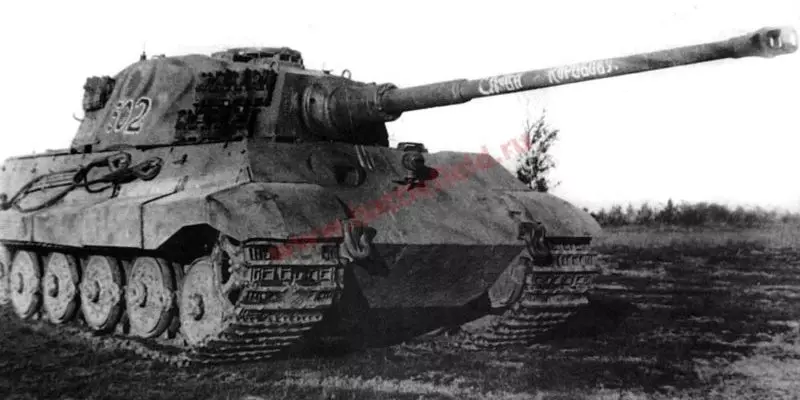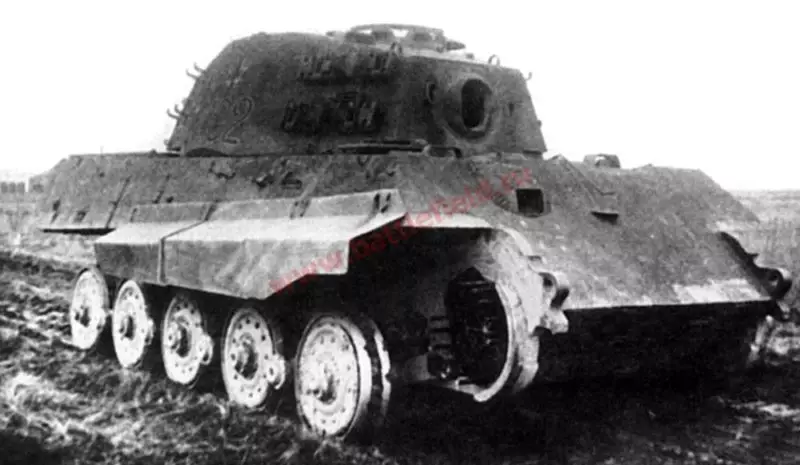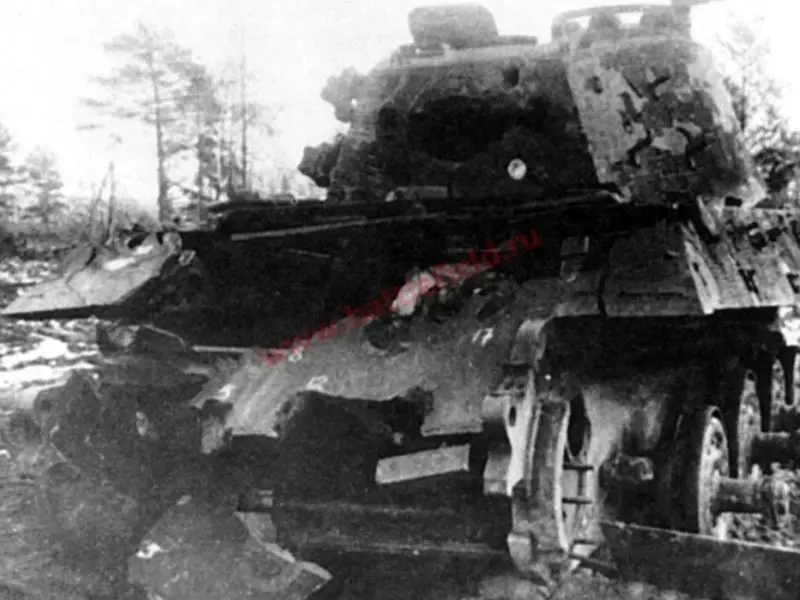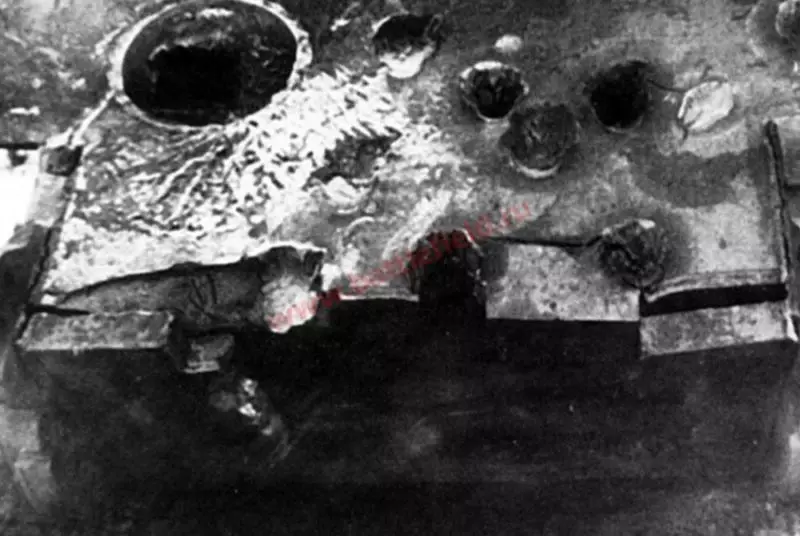
A heavy tank PZ KPFW Tiger Ausf in (according to the Germans adopted by the unified system, the SD KFZ 182 was also called SD KFZ 182 - "Special combat vehicle type 182") was developed at Henchel under the guidance of her chief designer Erwin Anders and serially produced from January 1944 May 1945.
The tank mass was 69.4 tons, the specific power is 10.08 hp / t. The housing and the tower were made of rolling homogeneous armor and low hardness armor. A total of 487 cars were released.
The first tanks "Tiger-b", captured by our troops, were delivered to Cube to the scientific and test armored polygon GBTU for a comprehensive study. These were cars with numbers 102 and 502. After moving the tanks, numerous defects were revealed to our stroke at the loading station: the left sludge was faced with the 86th km. The heat that stood these days up to 30 degrees Celsius was excessive for the cooling system, which led to overheating of the right engine block and to permanent overheats of the checkpoint.
We did not have time to repair the tank, as the right on-board transfer was completely destroyed, which was replaced by the removed from another tank, but it was out of order due to the destruction of the roller bearing of the leading shaft. In addition, the case had to change the tracts of caterpillars, subject to destruction, especially when turning. The design of the caterpillars tension mechanism was not fully worked out, because of which every 10-15 km march had to regulate their tension.
In the end, both trophies were delivered to the NIIBT polygon, where the machine number 102 was subjected to further running tests. Tests passed with great difficulties associated with the extremely low reliability of the elements of the chassis, power plant and transmission. It was found that 860 liters of gasoline grabs only 90 km of movement on a country road, although the instructions for the car indicated that this gasoline should have 120 km. Fuel consumption per 100 km was 970 liters, instead of 700 l according to the same (captured) instruction. The average speed of the highway amounted to 25-30 km / h, and on the country road - 13.4-15 km / h. The maximum speed specified in the technical documentation of the tank, 41.5 km / h to achieve on the running tests never once and failed.
For an objective assessment of the armor of the tank, the case was made to subjected to the shelling case and the tower of a trophy machine with a tower number No. 102, most of the nodes and aggregates with which was dismantled for further research. Tank weapons were sent for research on aniop.

The fiction tests were held in the fall of 1944 in Cuban, and during them the following results were obtained:
"The quality of the TiGR-B's armor tank compared to the quality of armor tanks:" Tigr-H "," Panther "and Su" Ferdinand "of the first issues, deteriorated sharply. In the trigger tank "Tigr-b" from the first single hits, cracks and interference are formed. From the shelling group (3-4 shells) in the armor, the leaving and breaks of a large value are formed.
For all housing knots and tank tower characteristic is the weakness of welds. Despite the careful execution, the seams in the shelling behave much worse than this took place in similar designs of Tiger Tanks, Panther and Su Ferdinand.
In the armor of the windshield sheets of a tank with a thickness of 100 to 190 mm, if they hit them 3-4 armor-piercing or fragant-burglar shells of the Arsystem of the caliber of 152, 122 and 100 mm, from a distance of 500-1000 m, cracks, salvations and destruction of welds are formed, Increased violation of the operation of the transmission and the output of the tank of the order as irrevocable losses.
Armored shells of BS-3 guns (100 mm) and A-19 (122 mm) produce through breaks in the edge or joints of the head-boring sheets of the TiGR-B tank case at distances of 500-600 m.
Armored shells of BS-3 cannons (100 mm) and A-19 (122 mm) produce through breaks in the windshield tank tank "Tiger-b" at distances 1000-1500m.
Armor-piercing 85-mm shells of guns D-5 and C-53 windshield sheets of the tank case do not break and do not produce any destruction of the design with a distance of 300 m.
The onboard armor sheets of the tank are distinguished by a sharp inequality compared to the frontal sheets and are the most vulnerable part of the armored corpte and tank tower.
The onboard sheets of the body and the tank tower make their way to the armor-piercing projectiles of the 85 mm domestic and 76-mm American cannon from a distance of 800-2000 m.
The onboard sheets of the body and the tank tower do not make it easy to armor-piercing projectiles of 76 mm of the domestic gun (ZIS-3 and F-34).
American 76-mm armor-piercing shells punch the onboard sheets of tank "TiGR-B" from a distance of 1.5-2 times large than domestic 85-mm armor-pipe shells. "

Here, for lovers of the "Royal Tiger" I want to say that the 122-mm tank gun D-25, installed on the Tanks of the IS-2, was a direct descendant of the Gaubitizers A-19. These tools were distinguished, mainly shutters and some technological features that did not influence the ballistics. Consequently, the armor-proof of both guns was the same. In addition, the 100-mm field gun BS-3 and the D-10 tank gun, installed in SUA Su-100, also had the same armor-proof.
With a laboratory study of the TiGR-B reservation, the TSNII-48 was noted that "a noticeably gradual decrease in the amount of molybdenum (M) on German tanks T-VI and T-V and the complete absence in T-U1B. The reason for the replacement of one element (M) to others (V - Vanadium) must be obviously looking for in the exhaustion of the reserves and losses of the bases that have provided Germany Molybdenum. Characteristic for the "Tigra-B" armor is a small viscosity. The advantage of domestic armor, as is known, is a much higher viscosity, the German armor is less doped, but also be less viscous. "
Here you also want to make a comment. More viscous armor gives a smaller number of secondary fragments at breakthrough, in addition, such armor has less chance of cracking.

During the test of weapons, the German tank gun KWK 43 showed good results on armor-proof and cuminess: almost the same as the Soviet 122-mm cannon D-25 Tank IP-2. So, on a distance of 1000 m, the following deviations of projectiles from the aiming point were obtained: 260 mm vertically and 210 mm horizontally.
For comparison, the Gun D-25 Tank is-2, the average deviation of the shells from the target point during shooting from a distance of 1000 m vertically did not exceed 170 mm, and horizontally 270 mm. The armoredness of the 88-mm gun KWK 43 with a barrel length of 71 caliber, at the initial velocity of the armor-piercing projectile 1000 m / s for a distance of 1000 m was 165 mm at an angle of a 30 degree. In particular, the tower of his "fellow" "Tigr-b" struck with a range of 400 m. But according to the power of the fugasal action 88-mm, the projectile was inferior in 1.39 times with a 122-mm fragmentation fuke-making projectile.

In the final report of February 16, 1945 on Tigra-B testing, it was said:
"The frontal armor of the hull and a low-quality tower. In the presence of missing lesions (dents), cross-cutters are formed in armor and large courses from the back. The onboard sheets are distinguished by a sharp inequalization compared to the windshield and are the most vulnerable part of the armored hull and tank tower.
Disadvantages: the running part is complex and short-lived. power tank. "
Capital photo: Royal Tiger No. 502
Source: "Tankomaster" № 6 1999
